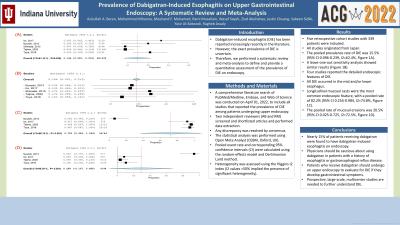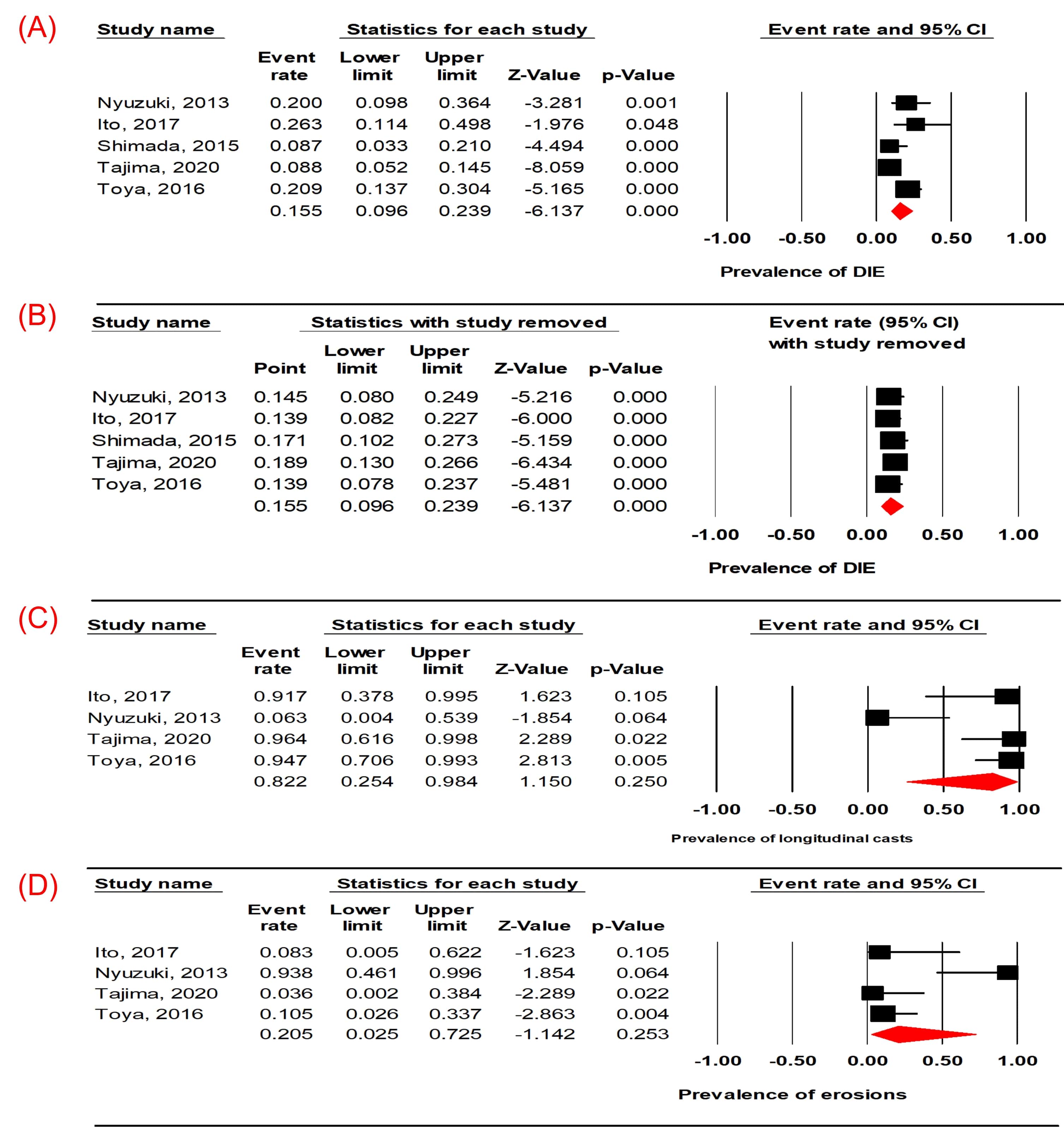Back


Poster Session B - Monday Morning
Category: Esophagus
B0210 - Prevalence of Dabigatran-Induced Esophagitis on Upper Gastrointestinal Endoscopy: A Systematic Review and Meta-Analysis
Monday, October 24, 2022
10:00 AM – 12:00 PM ET
Location: Crown Ballroom

Has Audio
.jpg)
Azizullah Beran, MD
University of Toledo
Toledo, OH
Presenting Author(s)
Azizullah A. Beran, MD1, Mohammed Mhanna, MD1, Mouhand F. Mohamed, MD, MSc2, Rami Musallam, MD3, Wasef Sayeh, MD4, Ziad Abuhelwa, MD1, Justin Chuang, MD4, Sabeen Sidiki, MD4, Yasir Al-Abboodi, MD4, Ragheb Assaly, MD1
1The University of Toledo, Toledo, OH; 2Warren Alpert Medical School of Brown University, Providence, RI; 3St. Vincent Charity Medical Center, Cleveland, OH; 4University of Toledo, Toledo, OH
Introduction: Dabigatran-induced esophagitis (DIE) has been reported increasingly recently in the literature. However, the exact prevalence of DIE is uncertain. Therefore, we performed a systematic review and meta-analysis to define and provide a quantitative assessment of the prevalence of DIE on endoscopy.
Methods: A comprehensive literature search of PubMed/Medline, Embase, and Web of Science was conducted on April 01, 2022, to include all studies that reported the prevalence of DIE among patients undergoing upper endoscopy. Two independent reviewers (AB and RM) screened and shortlisted articles and performed data extraction. Any discrepancy was resolved by consensus. The statistical analysis was performed using Open Meta Analyst (CEBM, Oxford, UK). Pooled event rate and corresponding 95% confidence intervals (CI) were calculated using the random-effects model and DerSimonian Laird method. Heterogeneity was assessed using the Higgins I2 index (I2 values >50% implied the presence of significant heterogeneity).
Results: Five retrospective cohort studies with 339 patients were included. All studies originated from Japan. The pooled prevalence rate of DIE was 15.5% (95% CI 0.096-0.239, I2=62.4%, Figure 1A). A leave-one-out sensitivity analysis showed similar results (Figure 1B). Four studies reported the detailed endoscopic features of DIE. All DIE occurred in the mid and/or lower esophagus. Longitudinal mucosal casts were the most common endoscopic feature, with a pooled rate of 82.2% (95% CI 0.254-0.984, I2=74.8%, Figure 1C). The pooled rate of mucosal erosions was 20.5% (95% CI 0.025-0.725, I2=72.5%, Figure 1D).
Discussion: Nearly 15% of patients receiving dabigatran were found to have dabigatran-induced esophagitis on endoscopy. Physicians should be cautious about using dabigatran in patients with a history of esophagitis or gastroesophageal reflux disease. Patients who receive dabigatran should undergo an upper endoscopy to evaluate for DIE if they develop gastrointestinal symptoms. Prospective, large-scale, multicenter studies are needed to further understand DIE.

Disclosures:
Azizullah A. Beran, MD1, Mohammed Mhanna, MD1, Mouhand F. Mohamed, MD, MSc2, Rami Musallam, MD3, Wasef Sayeh, MD4, Ziad Abuhelwa, MD1, Justin Chuang, MD4, Sabeen Sidiki, MD4, Yasir Al-Abboodi, MD4, Ragheb Assaly, MD1. B0210 - Prevalence of Dabigatran-Induced Esophagitis on Upper Gastrointestinal Endoscopy: A Systematic Review and Meta-Analysis, ACG 2022 Annual Scientific Meeting Abstracts. Charlotte, NC: American College of Gastroenterology.
1The University of Toledo, Toledo, OH; 2Warren Alpert Medical School of Brown University, Providence, RI; 3St. Vincent Charity Medical Center, Cleveland, OH; 4University of Toledo, Toledo, OH
Introduction: Dabigatran-induced esophagitis (DIE) has been reported increasingly recently in the literature. However, the exact prevalence of DIE is uncertain. Therefore, we performed a systematic review and meta-analysis to define and provide a quantitative assessment of the prevalence of DIE on endoscopy.
Methods: A comprehensive literature search of PubMed/Medline, Embase, and Web of Science was conducted on April 01, 2022, to include all studies that reported the prevalence of DIE among patients undergoing upper endoscopy. Two independent reviewers (AB and RM) screened and shortlisted articles and performed data extraction. Any discrepancy was resolved by consensus. The statistical analysis was performed using Open Meta Analyst (CEBM, Oxford, UK). Pooled event rate and corresponding 95% confidence intervals (CI) were calculated using the random-effects model and DerSimonian Laird method. Heterogeneity was assessed using the Higgins I2 index (I2 values >50% implied the presence of significant heterogeneity).
Results: Five retrospective cohort studies with 339 patients were included. All studies originated from Japan. The pooled prevalence rate of DIE was 15.5% (95% CI 0.096-0.239, I2=62.4%, Figure 1A). A leave-one-out sensitivity analysis showed similar results (Figure 1B). Four studies reported the detailed endoscopic features of DIE. All DIE occurred in the mid and/or lower esophagus. Longitudinal mucosal casts were the most common endoscopic feature, with a pooled rate of 82.2% (95% CI 0.254-0.984, I2=74.8%, Figure 1C). The pooled rate of mucosal erosions was 20.5% (95% CI 0.025-0.725, I2=72.5%, Figure 1D).
Discussion: Nearly 15% of patients receiving dabigatran were found to have dabigatran-induced esophagitis on endoscopy. Physicians should be cautious about using dabigatran in patients with a history of esophagitis or gastroesophageal reflux disease. Patients who receive dabigatran should undergo an upper endoscopy to evaluate for DIE if they develop gastrointestinal symptoms. Prospective, large-scale, multicenter studies are needed to further understand DIE.

Figure: Figure 1: (A) forest plot showing the pooled overall prevalence of dabigatran-induced esophagitis. (B) Leave-one-out sensitivity analysis for prevalence of dabigatran-induced esophagitis. Forest plots showing the pooled rate of (C) longitudinal mucosal casts and (D) erosions in dabigatran-induced esophagitis.
Disclosures:
Azizullah Beran indicated no relevant financial relationships.
Mohammed Mhanna indicated no relevant financial relationships.
Mouhand Mohamed indicated no relevant financial relationships.
Rami Musallam indicated no relevant financial relationships.
Wasef Sayeh indicated no relevant financial relationships.
Ziad Abuhelwa indicated no relevant financial relationships.
Justin Chuang indicated no relevant financial relationships.
Sabeen Sidiki indicated no relevant financial relationships.
Yasir Al-Abboodi indicated no relevant financial relationships.
Ragheb Assaly indicated no relevant financial relationships.
Azizullah A. Beran, MD1, Mohammed Mhanna, MD1, Mouhand F. Mohamed, MD, MSc2, Rami Musallam, MD3, Wasef Sayeh, MD4, Ziad Abuhelwa, MD1, Justin Chuang, MD4, Sabeen Sidiki, MD4, Yasir Al-Abboodi, MD4, Ragheb Assaly, MD1. B0210 - Prevalence of Dabigatran-Induced Esophagitis on Upper Gastrointestinal Endoscopy: A Systematic Review and Meta-Analysis, ACG 2022 Annual Scientific Meeting Abstracts. Charlotte, NC: American College of Gastroenterology.
